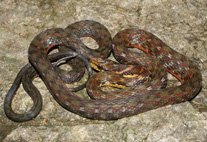Abstract
The ostracode genus Bicornucythere (Ostracoda, Crustacea) is abundant in modern-day eutrophic marine bays, and is widely distributed in estuaries and inner bays throughout East Asia, including in China, Korea, Japan, and the Russian Far East. The evolutionary history of Bicornucythere is poorly understood. Here, we report on a new species of Bicornucythere (Bicornucythere concentrica sp. nov.) from the upper Eocene Yaw Formation in the Central Myanmar Basin. The oldest previously known Bicornucythere taxon, Bicornucythere secedens, was reported from lower Miocene strata in India, although a molecular phylogeny suggests that the genus first appeared in the Late Cretaceous. Bicornucythere concentrica sp. nov. is at least 10.9 million years older than the earliest known B. secedens. The new species occurs with Ammonia subgranulosa, a benthic foraminifer, an association that is representative of brackish water conditions in modern Asian bays. Our findings indicate that extant genera have inhabited Asian bays since the late Eocene. The paleobiogeography of Bicornucythere indicates that the taxon was dispersed onto Indian coasts during the collision between the Indian and Eurasian plates.

